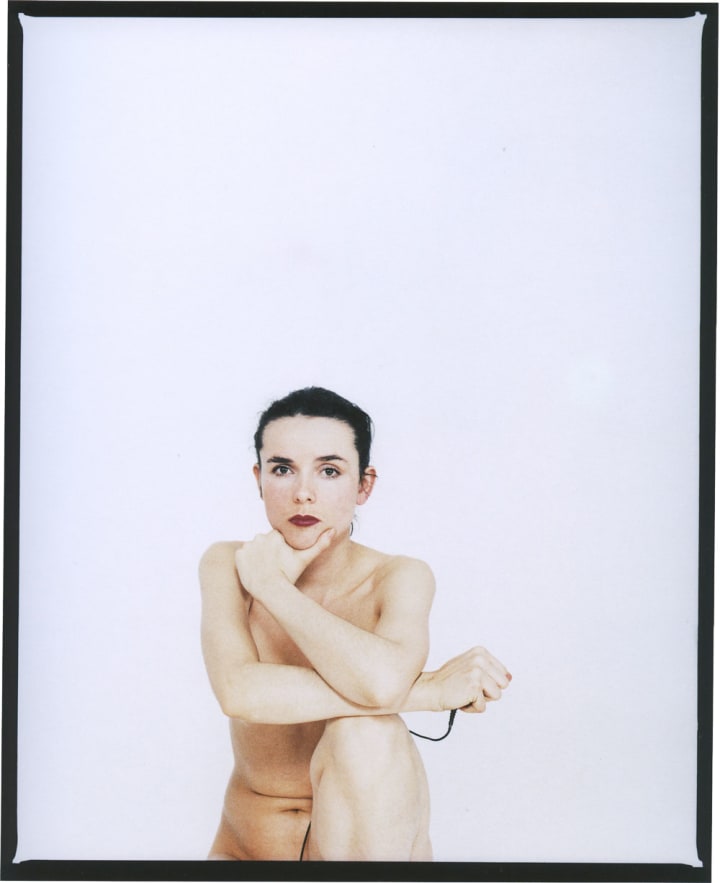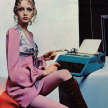Nude Self Portraits of 100 Women
André Rival's 'Self-Images: 100 Women' explores body image through nude self portraits.

They weren’t wearing hats, and in 1923 women without hats sitting in public cafés were looked upon, even in Paris, as prostitutes. Man Ray, the great dadaist artist and photographer, once observed the prejudice and described it in his illustrated biography entitled Self-Portrait. One of the two young ladies was Kiki, a model much sought after by the poor painters of Montparnasse who later gained worldwide fame; She soon became Man Ray’s mistress and his favorite model as well.
Man Ray was forced to exploit his persuasive talents to the fullest, of course, before the young woman agreed to undress in his studio. "... and then she appeared, modestly covering herself with her hand, looking exactly like the figure in Ingre’s painting 'La source.' " It all seems a bit like a period piece for Netflix in contrast to the photographic project undertaken by renowned artist André Rival. No longer is there an unwritten law that compels women to dress in a particular way—at least not in the societies that make up our western civilization. And a wink with the camera often suffices to attract models as if by magic.





A Bold and Unusual Undertaking
Nevertheless—even at a time when all inhibitions seem to have been stripped off along with discarded clothing, when pornography rules almost unchallenged over the terrain of the erotic, a project such as Rival’s was certainly a bold and unusual undertaking. He persuaded 100 women to photograph themselves—for a book already planned. The sole condition: They had to be nude. Such a notion is certainly not unusual in itself. In fact, it is standard practice for a certain species of magazines. What is unusual is the manner in which the photographer proposed to carry it out; for he specified only the externals of each and every photograph: By setting up the camera beforehand, he pre-determined the pictorial format. He also prescribed the spatial relationships operating within the setting. An empty living room served as a studio.
Its white walls provided the background, and the wood floors were also covered with a white material. Uncomplicated lighting ensured an evenly-distributed, shallow illumination. That changed only when the models moved in front of the immobile camera. In addition to the photographic equipment and the lighting source, a video camera and a monitor were placed in the room. The field of view shown on the video screen was nearly identical to that of the camera, thus enabling the models to control their photographic images rather precisely. A few rectangular wooden or plastic pedestals, painted white, were the only props. Finally, André Rival made two further noteworthy decisions: to use a medium-frame camera and to photograph in color instead of black-and-white.

Self-Staged Photos
He was not present during the actual photographing. And therein lies the truly unusual aspect of his undertaking. Voluntarily, he bowed to the power of the 100 persuaded women to stage their own photographs. He purposely refused, sans the voyeurism, to influence the process in any way—beyond the requirements he had already established. The choice of how they were to be portrayed was left entirely to the women. Within the predetermined external framework they enjoyed total freedom.
For this as well was one of the pre-conditions: The photographer was not permitted to reject any of the photographs produced. That privilege was reserved exclusively for the models themselves. And it was not until photographer and model had arrived together at a selection of each woman's photographs that Rival showed his respective protagonists the pictures of the others.
It would have been entirely understandable had he, despite his youth already an experienced photographer able to look back up on a considerable number of publications, chosen his models from the immediate surroundings of his discipline—professional photo models or actresses. But this was precisely what he did not want. On the one hand, using only professional models would have increased his influence up on the results of the photographic experiment immeasurably. When they know a photographer, they offer exactly the repertoire he is looking for to begin with. On the other hand, Rival originally envisioned something more than a photographic experiment.
His intent had been to provide, in a comprehensible visual form, a representative analysis of female behavior in front of the camera, a contribution, so to speak, to human behavioral research. This explains the unusual role-play he devised. The fact that he required his models to pose naked before the camera is less the expression of erotic and sexual desires than of his concern for authenticity. The view behind the mask of clothing. Nothing but the truth, the naked truth. The photographer soon realized that he had set his sights too high. Without employing the precise scientific instruments of statistics and survey methods he could never have achieved a reliable statement. And the cost in time and effort would have been immense—any gain in insight into the complicated mechanisms of human behavior, on the other hand, relatively slight.
Thus Rival limited the number of participants in his experiment to a manageable quantity. And the longer he worked on the project, almost a year in all, the more clearly he recognized that he was faced with a very specific photographic challenge, a challenge from both a professional and an aesthetic standpoint. Didn't photography's early proponents speak of it, after all, with such enthusiasm as an artistic medium without an artist? A popular idea at that time was the image of a Raphael with no hands. It is no wonder that most artists categorically rejected photography for this very reason. At the same time, the conception of a kind of self-operating mode of artistic expression has always fascinated photographic theorists.






Absence of Human Intervention
"For the first time," declared André Bazin in his brilliant essay on the "Ontology of the Photographic Image," "for the first time—in accordance with a strict determinism—an image of the external world is produced automatically, without the creative intervention of a human being... All forms of art are founded upon the presence of the human being. Photography alone takes advantage of its absence. It affects us like a 'natural phenomenon.' like a flower or a snowflake, whose beauty is inseparable from its botanical or earthly origin." This noteworthy film critic finds credibility in photographic images, as the trend towards automation had led to the creation of an objective image and roughly shaken the foundations of psychology.
A "deed without a doer," is the term used by the essayist Martin Burckhardt with respect to photography. "Once exposed, the image develops entirely on its own, and the photographer is left with nothing but his role as a catalyst, one who fires the starting pistol, who turns on the ignition that sets the machine inside the black box in motion." Of course, someone like Man Ray saw things quite differently. "... I photograph like I paint, transform the model just as the artist does, and I could refine it or reform it like a painter as well." Photography has attracted and crystallized a number of paradoxes around itself. In one way or the other all of the comments quoted here are related to them—an automatic process and to the same extent a technical instrument for artistic expression.
Their motives were as various as their physical features. Some were simply interested in a more intense experience. One of the protagonists wished only to take her picture—she didn’t want to look at it afterwards, nor did she wish to see the photos of the other women.

Real Vs Manufactured
An astonishing aspect is the wide spectrum of poses contained in the photographs. Open and hidden references to the arsenal of art history—to pictures by Ingres and Man Ray, for instance—and of commercial photography alternate with ironic citations and intentional provocations directed at the—male?—camera eye; alongside uninhibited pleasure in showing off one's own body we also find reticence in revealing one's self before an anonymous camera—in the knowledge, of course, that the photographs were to be published. Occasionally, carefully veiled fears come to the surface without warning. However, to give in to the temptation to interpret too quickly would be to venture on to thin ice.
For most of the participants appear to have mastered the art of playing with and before the camera. What is authentic, and what is merely feigned? Is the woman who spreads her legs in apparent shamelessness really an exhibitionist, and is the next, shy and hesitant, a sensitive angel? Viewers must be on their guard, or phantasy will get the best of them. No one is in a position to form a definitive judgment about the women portrayed. They are playing roles, and not even the question of whether their reliance upon past models is conscious or unconscious can be answered reliably. This much, however, is clear: There is no clearly defined female image. Here as well, the watch word is pluralism. Body image is a subjective perception. Each woman’s view of herself is individual in nature. To explore the various self images models chose to reveal, see the photographs themselves in Self-Images: 100 Women.
Self-Images: 100 Women details a series of models on a seamless white background with no props. The women, all from different walks of life and of different ages, decide what moment to capture on camera. This is one of, if not the absolute, first book of photography where the photographer is not in control of the camera. This volume portrays a successful experiment in the model exerting control over her environment and the exploration of one’s self-image.
About the Creator
Filthy Staff
A group of inappropriate, unconventional & disruptive professionals. Some are women, some are men, some are straight, some are gay. All are Filthy.






Comments
There are no comments for this story
Be the first to respond and start the conversation.